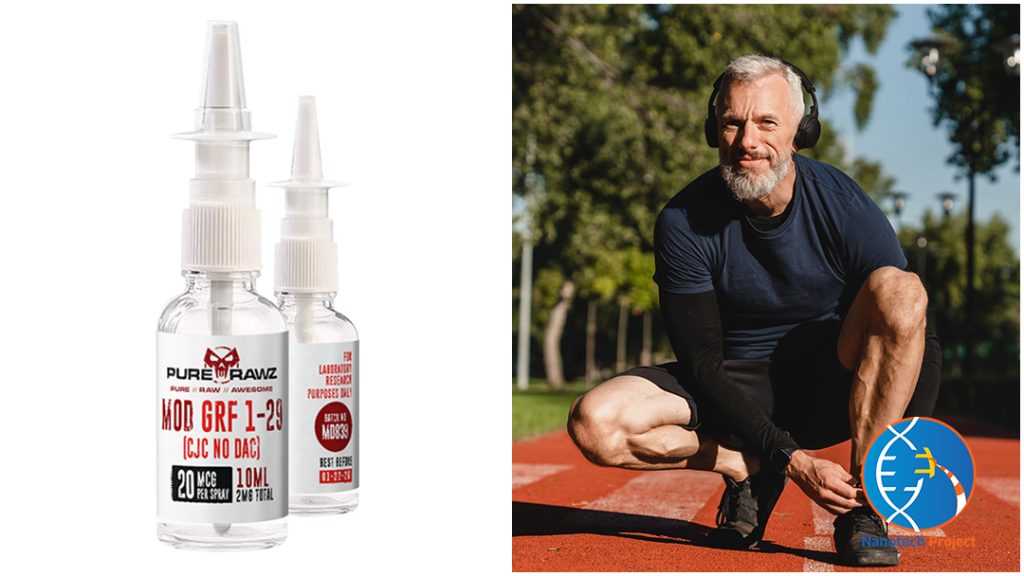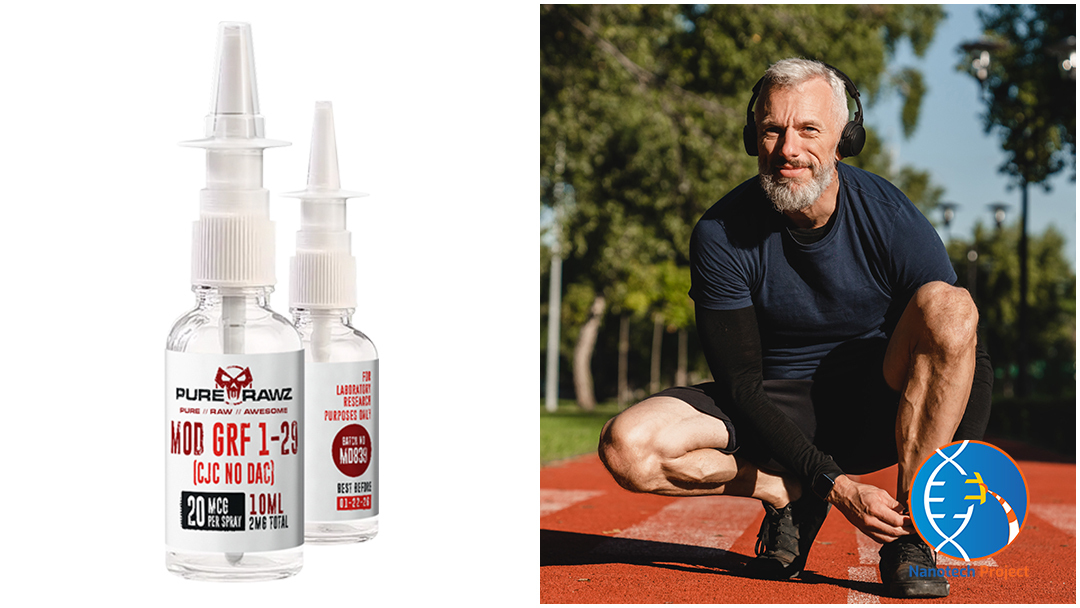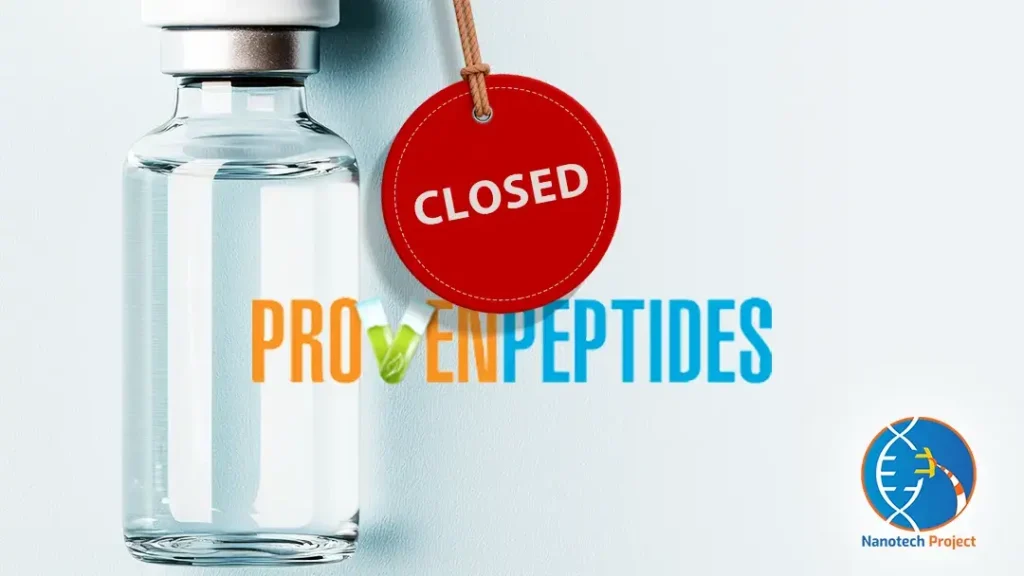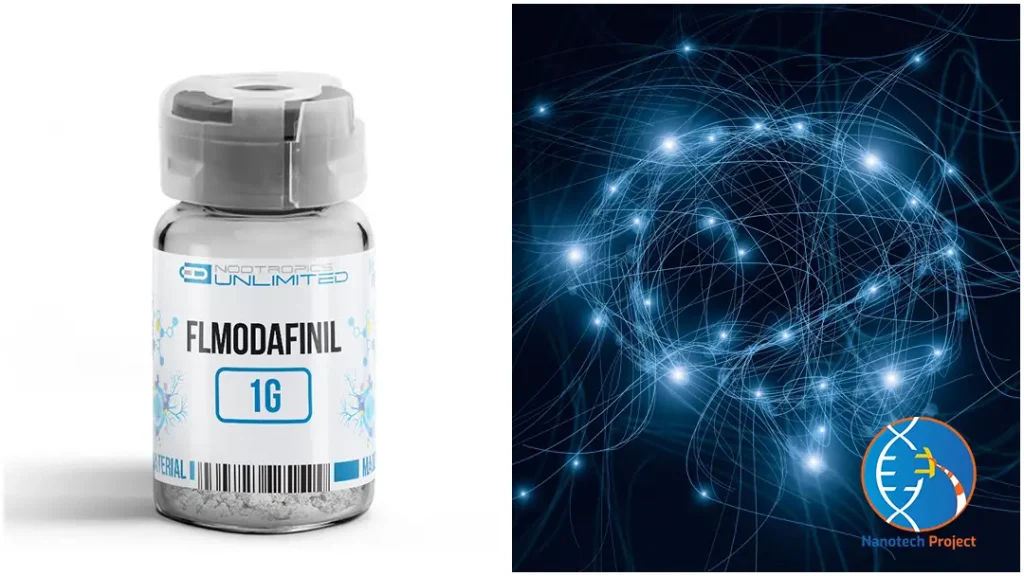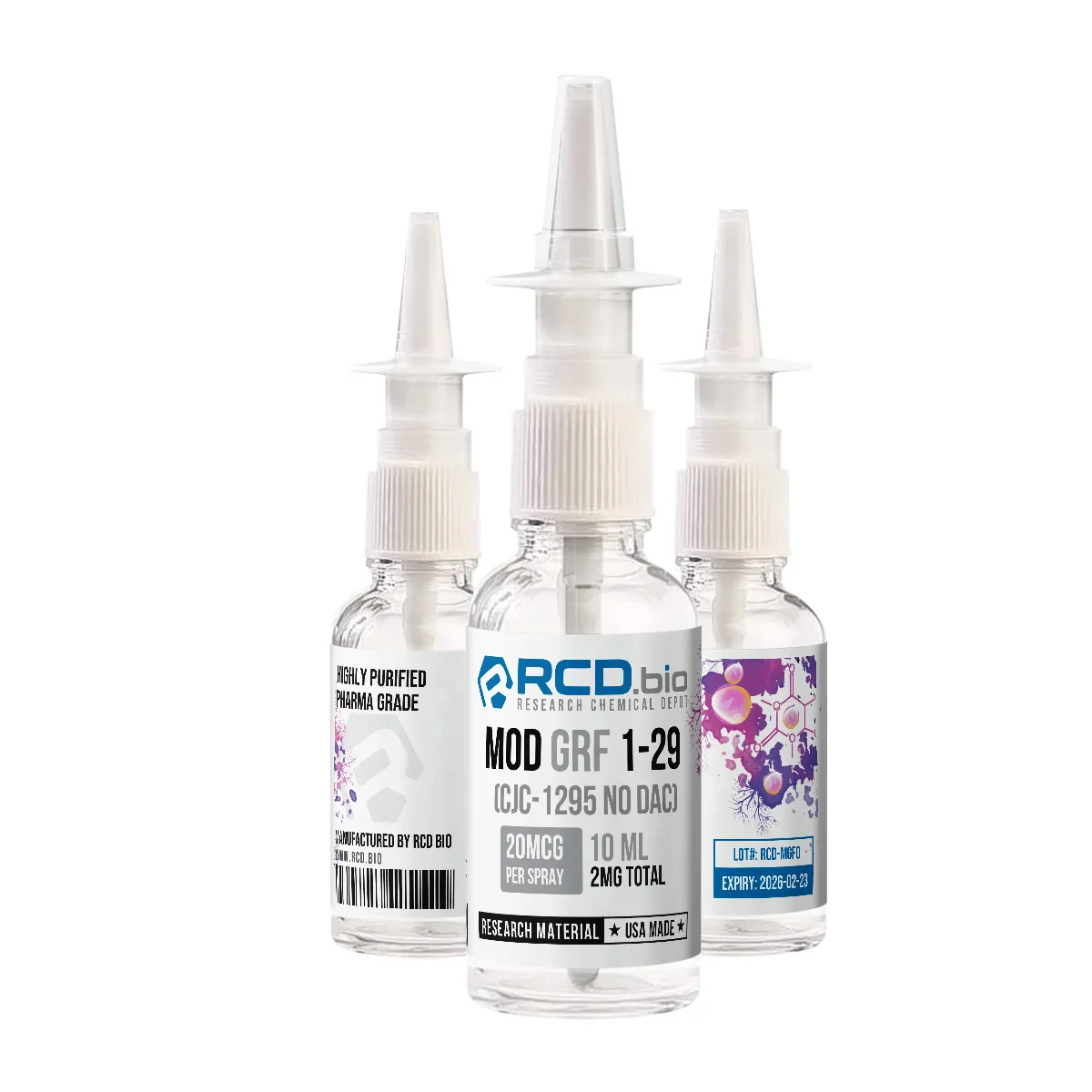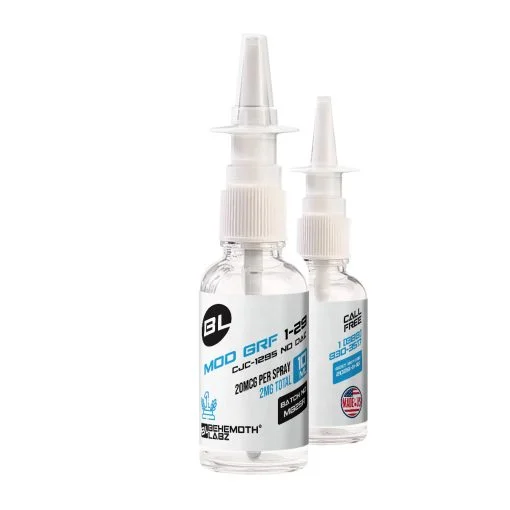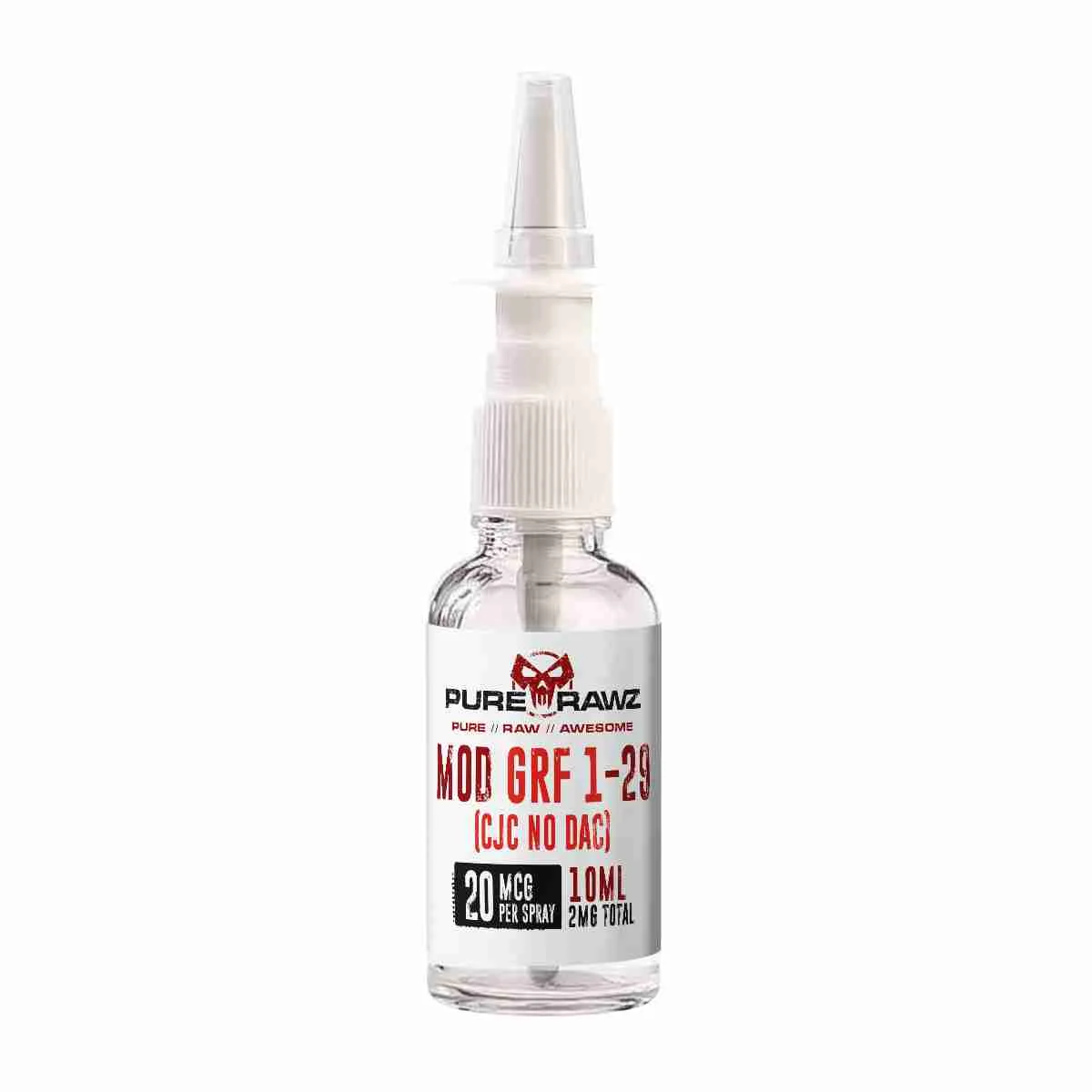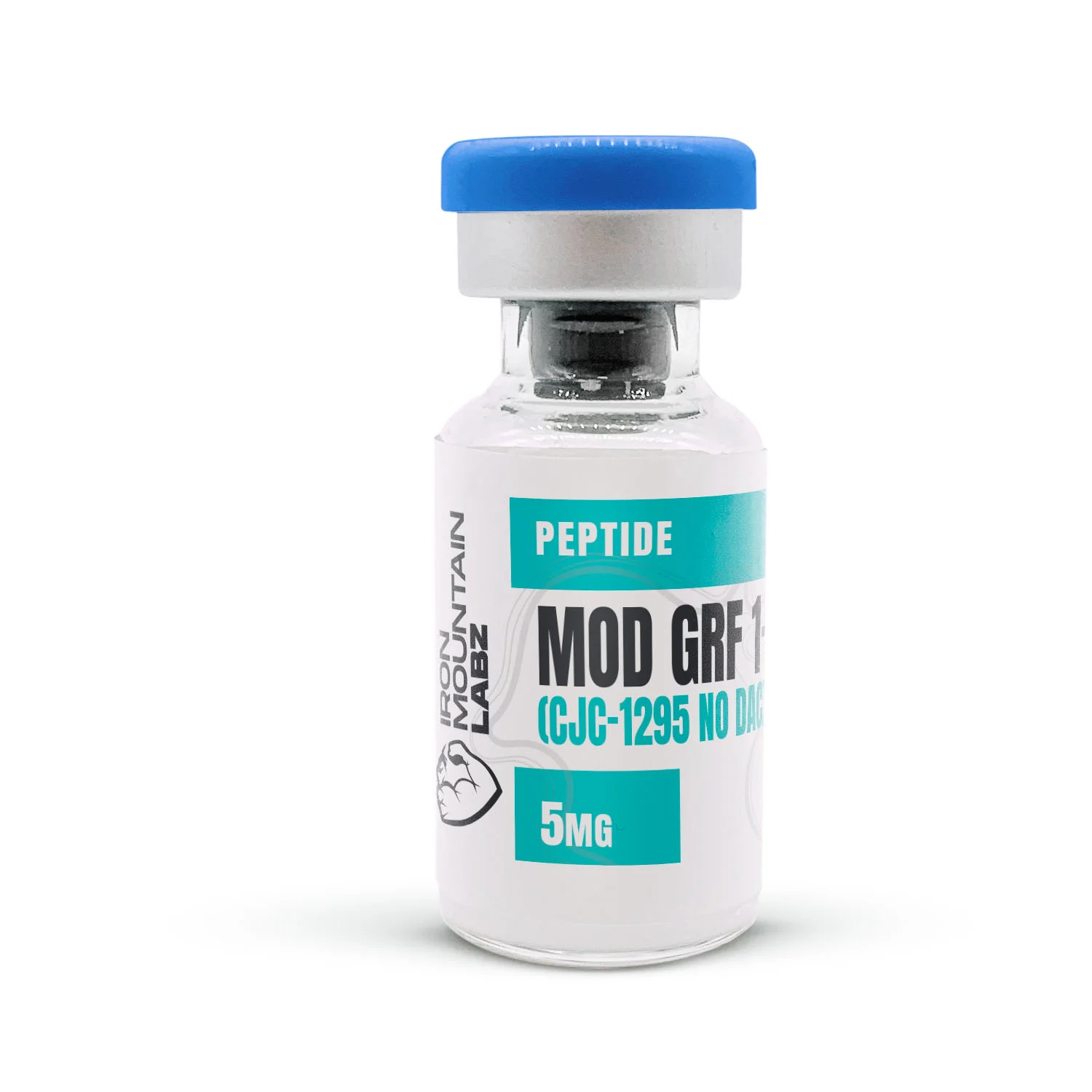Do you feel more and more helpless as you battle the effects of aging or ongoing health issues? The answer you’ve been looking for might be Mod GRF 1-29, or CJC-1295 No Dac. This synthetic version of GHRH is getting a lot of attention because of the promising effects it may have on aging issues like increasing lean body mass and decreasing fat. Mod GRF 1-29 provides a compelling path for those looking to improve their health in a variety of ways, including by boosting the immune system, losing weight, and improving their memory and concentration. Come along as we investigate the amazing potential of this peptide analog to revitalize many facets of life.
Introduction
Mod GRF 1-29, also known as CJC-1295 No Dac, is a synthetic analog of the first 29 amino acids of the growth hormone-releasing hormones (GHRH). It was initially developed by ConjuChem Biotechnologies to enhance its plasma half-life by utilizing a bioconjugation technique called Drug Affinity Complex (DACTM). This technique allows it to covalently bind to albumin in the body, resulting in an extended duration of action. Unlike other compounds like Ipamorelin and GHRP-6, which stimulate serum growth hormone levels release through the ghrelin pathway, Mod GRF 1-29 acts on the GHRH signaling pathway to induce the secretion of endogenous human growth hormone.
Product Information:
Mod GRF 1-29 (CJC-1295 No Dac) is a fascinating peptide analog of growth hormone-releasing hormone (GHRH) with a host of potential benefits. Research indicates that it may enhance muscle repair and growth, accelerate wound healing, strengthen bones, increase fat burning, and improve metabolism. It might also play a role in regulating blood sugar and boosting the immune system.

What makes Mod GRF 1-29 truly stand out is its innovative spray form. Unlike traditional capsules, the spray format offers a user-friendly, efficient way to unlock the potential of this remarkable compound. Its quick absorption and precise dosing make it a convenient choice for those seeking to explore the benefits of this peptide. Whether you’re an athlete aiming to maximize muscle growth or someone interested in overall well-being, Mod GRF 1-29 in spray form provides a hassle-free way to experience its powerful effects.
How Does It Work?
A variety of factors contribute to the decrease in GH secretion with aging. It can result from a reduction in GHRH (Growth Hormone-Releasing Hormone) and ghrelin, which are crucial stimulators of GH release. Additionally, somatostatin, a hormone that inhibits GH secretion, may become more prevalent as we age. However, studies have shown that the pituitary gland, responsible for GH production, remains responsive to GHRH stimulation in healthy older individuals. This implies that a part of the decline in spontaneous GH secretion may be attributed to a relative growth hormone deficiency of endogenous GHRH and/or ghrelin.
Furthermore, some individuals, particularly those who are overweight or less healthy, experience a decrease in the GH response to GHRH, possibly due to an increase in somatostatin levels. Interestingly, simultaneous administration of the amino acid arginine, known to inhibit somatostatin among other effects, enhances the GH response in older adults. In conclusion, current evidence suggests that the age-related decline in GH secretion is a multifactorial process, involving a decrease in GHRH and/or ghrelin activity and an increase in somatostatin. Mod GRF 1-29, by stimulating GHRH receptors, may offer a promising alternative to directly replacing GH in addressing this decline associated with normal aging.
Mod GRF 1-29 (CJC-1295 No Dac) – Benefits:
Mod GRF 1-29 (CJC-1295 No Dac) has undergone extensive clinical research and clinical trials, exploring its potential health benefits, especially in the context of growth hormones. We’ve compiled some of the benefits below:

1. Increases Cell growth
A recent study has shown that a substance called Mod GRF 1-29 (also known as CJC-1295 No Dac) can have a significant impact on the behavior of certain cells in our bodies. These cells, found in a type of lung tumor called bronchial neuroendocrine tumor cells, are involved in various processes like cell growth, survival, and the release of important substances.
When these cells were exposed to Mod GRF 1-29 at specific concentrations, they started to grow more, and this growth was associated with an increase in the release of two important substances: vascular endothelial growth factor (VEGF) and chromogranin A. These substances play key roles in the body, and their increased release suggests that Mod GRF 1-29 can affect the behavior of these cells in a way that may be relevant to lung tumors.
This study provides us with new information about how Mod GRF 1-29 can impact the behavior of these cells. It suggests that this substance might act as a signal, encouraging the growth and activity of these cells in the context of lung tumors.
2. Rejuvenating the Aging Immune System
Aging is often associated with a decline in the functioning of the GH-insulin-like growth factor I (IGF-I) axis and the immune system, which can impact an individual’s overall health. However, a fascinating hypothesis was put to the test in a single-blind, randomized, placebo-controlled trial lasting five months. The study aimed to investigate whether the administration of Growth Hormone-Releasing Hormone (GHRH) could restore the GH-IGF-I axis and enhance immune cell function in elderly subjects.
The results of this trial were nothing short of remarkable. Treatment with a GHRH analog led to a significant increase in GH secretion and serum IGF-I levels in both men and women. This surge in GH and IGF-I, maintained for several weeks, triggered a substantial activation of the immune system. Within just four weeks, there was a notable increase in specific immune cell populations, such as lymphocytes and monocytes, in both men and women. The positive immune response continued, with enhancements in B cell numbers, T cell subsets, and natural killer cells by the 16-week mark. These changes were accompanied by improved responsiveness to various immune triggers, indicating that GHRH analog administration could hold therapeutic potential for individuals with compromised immune function.
In essence, Mod GRF 1-29 (CJC-1295 No Dac), a GHRH analog, emerges as a fascinating avenue for rejuvenating the aging immune system. The study’s findings offer promise for individuals facing immune challenges, highlighting the potential of this therapy to enhance immune function and overall well-being. The immune-enhancing effects of GHRH analog therapy bring hope to the quest for a healthier and more vibrant life, even in the face of the aging process.
3. Boosted Lean Body Mass, Insulin Sensitivity, Well-Being, and Libido
Aging often brings about changes in body composition and metabolism, largely influenced by the attenuation of the Growth Hormone (GH) and Insulin-like Growth Factor I (IGF-I) axis. Previous studies have explored the benefits of recombinant human GH replacement in aging individuals but encountered adverse effects that limited its clinical utility. As an alternative approach, the use of Growth Hormone-Releasing Hormone (GHRH) or its analogs has gained attention for restoring the GH-IGF-I axis in aging individuals.
A single-blind, randomized, placebo-controlled trial spanning 5 months shed light on the endocrine-metabolic changes in response to a GHRH analog in age-advanced men and women. The trial involved nightly GHRH analog administration, which induced an acute release of GH within 10 minutes, lasting for 2 hours. Notably, the GHRH analog led to a significant increase in 12-hour integrated nocturnal GH levels, accompanied by elevated IGF-I and IGFBP-3 levels. In men, this treatment resulted in increased lean body muscle mass and improved insulin sensitivity, along with enhanced general well-being and libido. However, skin thickness increased in both genders, with more prominent anabolic effects observed in men.
4. Optimizing Growth by Reducing Fat Content
In the pursuit of optimizing growth performance in Yorkshire-Landrace pigs, a comprehensive study involving sixty female pigs was undertaken, focusing on the effects of porcine growth hormone-releasing factor (pGRF), thyrotropin-releasing factor (TRF), and their combined influence. These treatments were administered through subcutaneous injections over a specified weight range, using a 2×2 factorial design. The study’s findings shed light on the intriguing impact of these growth factors.
The results of this study unveiled the multifaceted influence of these factors on various growth and carcass characteristics. Notably, pGRF, when administered at specific doses, positively affected carcass characteristics by reducing backfat thickness and increasing carcass length, as well as the area of the loin eye. Additionally, pGRF contributed to an increase in lung and kidney weight. TRF, on the other hand, had a limited impact on growth performance but did reduce lung weight and raised blood-urea nitrogen levels after four weeks of treatment.
In conclusion, this research highlights the potential of Mod GRF 1-29 (CJC-1295 No Dac) in enhancing the growth and carcass characteristics of Yorkshire-Landrace pigs. While TRF showed limited effects, pGRF played a pivotal role in reducing fat content and enhancing key carcass attributes. These findings offer valuable insights into the world of livestock management, providing a potential avenue for optimizing growth in the pig farming industry.
5. Reduce Body Fat, Increase Lean Mass, and Enhance Cognitive Function
Aging brings about a decline in growth hormone (GH) secretion, but the aging pituitary remains responsive to GH secretagogues, such as GHRH and ghrelin mimetics. These compounds hold the potential to rejuvenate GH secretion in the elderly, offering an alternative to GH itself. The factors contributing to age-related GH decline often originate outside the pituitary, and with sustained administration of GH secretagogues, they can significantly boost GH secretion and raise insulin-like growth factor-I (IGF-I) levels back to those seen in young adults. The benefits of GH secretagogues include preserving feedback regulation by IGF-I to prevent over-treatment and generating a more physiologically natural pattern of GH secretion. Nonpeptide GH secretagogues can even be taken orally.
A key focus of this review is on GHRH (Mod GRF 1-29 or CJC-1295 No Dac). Research demonstrates that GHRH can stimulate the robust release of GH in healthy seniors. Furthermore, repeated GHRH administration leads to dose-dependent elevations of IGF-I levels. In clinical studies involving healthy older individuals, subcutaneous injections of GHRH(1-29)NH2 administered once nightly over six months increased nighttime GH secretion and sustained IGF-I levels. The benefits included increases in lean body mass and reductions in body fat, with a notable impact on visceral fat. While effects on physical function were variable, GHRH appeared to enhance cognitive function, particularly in domains sensitive to processing speed. The formulation used in these studies is short-acting, concluding its effects within a few hours. Side effects were primarily mild, and related to fluid retention. These studies offer promise for the use of GH secretagogues, particularly GHRH, in enhancing the well-being of aging individuals.
Side Effects:
Mod GRF 1-29 (CJC-1295 No DAC) is a synthetic peptide that boosts growth hormone production. Consider side effects when using a nasal spray. Growth hormone peptide combinations may not be regulated or well-studied for non-medical use, so information is limited. Here are some potential side effects associated with the use of Mod GRF 1-29 nasal spray:
- Headaches: Headaches have been reported by some users after the application of Mod GRF 1-29 nasal spray.
- Nausea or stomach upset may manifest as untoward effects, albeit infrequently.
- Lightheadedness or dizziness has been reported by some users after administering the nasal spray.
- Allergic Reactions: Rarely, individuals may manifest symptoms of an allergic reaction, including but not limited to skin rash, pruritus, or edema. Exercise caution if you have a prior history of allergies.
- Blood pressure fluctuations may be induced by Mod GRF 1-29; therefore, those predisposed to hypertension or cardiovascular conditions should exercise caution.
- A heightened appetite or hunger may manifest as a side effect in certain individuals.
Is Mod GRF 1-29 (CJC-1295 No Dac) legal?
The legal status of growth hormone-releasing peptides like Mod GRF 1-29 (CJC-1295 No Dac) can vary by country and region. In some places, these peptides may be considered legal for research purposes, while in others, they may be regulated or even prohibited. It’s important to note that the legality of such substances can change over time, and regulations may differ from one jurisdiction to another.
To determine the specific legal status of Mod GRF 1-29 (CJC-1295 No Dac) in your area, you should consult local and national laws, regulations, and guidelines related to research chemicals and peptides. Additionally, you may want to seek advice from legal or medical professionals who are knowledgeable about the regulations in your jurisdiction.
Suggested Dose:
The recommended dose of Mod GRF 1-29, also known as CJC-1295 No DAC, can vary depending on individual factors, such as your age, weight, and overall health, as well as the specific goals you are trying to achieve. Additionally, dosing recommendations may vary among healthcare professionals and research sources.
A common starting dose for Mod GRF 1-29 is 100 mcg (micrograms) administered once or twice a day. However, it’s crucial to work with a healthcare provider or a knowledgeable professional experienced in peptide therapies to determine the right dose for your specific needs and monitor your progress. Self-administering peptides without proper guidance can be risky and may lead to unintended side effects.
It’s important to note that Mod GRF 1-29 (CJC-1295 No DAC) is typically administered via subcutaneous injection and not as a nasal spray. The effectiveness and safety of using this peptide as a nasal spray have not been widely studied or established. If you are considering nasal administration, it’s advisable to exercise caution and consider starting with a low dose of around 20 mcg per spray, but please be aware that this method may not be as well-researched or proven as subcutaneous injection. Consulting with a healthcare professional or peptide therapy specialist is recommended for personalized guidance.
How is Mod GRF 1-29 (CJC-1295 No Dac) typically administered?
Mod GRF 1-29 is typically administered through subcutaneous injections, and it’s important to follow proper dosage instructions for safe and effective usage. However, for those who find injections less favorable, there is an alternative option available as a nasal spray. This is because some users may experience side effects, such as joint pain or discomfort at the injection site.
How does Mod GRF 1-29 stimulate growth hormone production?
A2: Mod GRF 1-29 functions by binding to and activating the growth hormone-releasing hormone (GHRH) receptors in the pituitary gland. This stimulation leads to increased growth hormone secretion, which can help with various physiological processes, including protein synthesis and tissue growth
Where to Buy Online
To buy Mod GRF 1-29 (CJC-1295 No Dac) nasal spray, PureRawz emerges as the ideal destination for growth hormone-releasing peptide. As a leading supplier of research chemicals, both online stores consistently offer reference materials alongside each product or research chemical in their inventory

Conclusion:
In conclusion, Mod GRF 1-29 (CJC-1295 No Dac) a peptide and amino acid, presents a remarkable avenue for individuals seeking to address the effects of aging and ongoing health issues. This synthetic peptide, derived from the first 29 amino acids of the growth hormone-releasing hormone (GHRH), has the potential to make a profound impact on various facets of well-being. From its role in increasing lean body mass, reducing body fat, and boosting metabolism to its potential in enhancing the immune system and cognitive function, Mod GRF 1-29 offers a promising path toward a healthier and more vibrant life. The convenient nasal spray format further simplifies its usage, ensuring a hassle-free experience for those exploring the benefits of this remarkable compound.
The research findings indicate that this growth hormonal agent peptide has the potential to rejuvenate the aging immune system, enhance muscle growth, and improve insulin sensitivity, well-being, and libido. While some side effects and legal considerations should be taken into account, the future of this peptide analog seems full of promise. However, it’s essential to approach its use with caution and seek guidance from healthcare professionals or peptide therapy specialists to ensure safe and effective administration. Mod GRF 1-29 opens new possibilities for those looking to take charge of their health and well-being, potentially turning back the clock on aging-related challenges.
